This is going to be difficult to explain to people in the year of our Raiden 2019, but Mortal Kombat went through the strangest metamorphosis between its initial release and the finale of Mortal Kombat 3 four years later. At launch, Mortal Kombat (1) was a revelation that not only lit the arcades ablaze like a thousand flaming skulls, but also was featured nigh-nightly on the evening news during segments that warned us all of “mature content” and the vicious seduction of our innocent children. Mortal Kombat was an arcade smash and the scariest goddamned thing in the world. Contrast this with 1996, when Mortal Kombat Trilogy was hitting home consoles. At this point, we had…

• Mortal Kombat cameos across the board
• The wildly successful Mortal Kombat movie
• Various Mortal Kombat comics, some directly from the franchise creators
• Mortal Kombat being the featured game on roughly every game/cheat magazine every other month
• The Mortal Kombat animated series, Defenders of the Realm
• Mortal Kombat action figure lines, including one set that was meant to scale with contemporary GI Joes
• And, of course, freaking events that accompanied every Mortal Kombat console release. It’s arguable that the release of the original Mortal Kombat on consoles, “Mortal Monday”, introduced a generation to the very concept of videogames having release dates (as opposed to weird hunks of plastic that were clearly just teleported into stores randomly from the future)
In short, Mortal Kombat went from being some dingy tech demo fighting game to the root of all evil to, eventually, a mainstay at toy stores across the country. Mortal Kombat had become arguably the face of gaming by 1996.
So you’ll forgive the curators of Mortal Kombat for believing they could do no wrong. You’ll have to forgive them for Mortal Kombat Mythologies: Sub-Zero.
On paper, this could have been a thing of beauty. The concept was simple: Mortal Kombat has a robust kast with interesting and complex “mythologies”, so why not produce some games that focus on non-fighting tournament based events? Not every problem can be solved by a round robin round of roundhouses, after all. And while we’re at it, let’s see if this “mythology” can tie into the inevitably convoluted backstory for the next “real” Mortal Kombat title. How much better would Shao Kahn be if you knew his whole deal before he popped out of nowhere in Mortal Kombat 2? So much better! One would assume! (Incorrectly!)
Unfortunately, MKM:S was not to be a beautiful unicorn, but more of a three-legged donkey that has been rolling in shit all day while another, fatter donkey stood there shouting MAGA slogans and various homophobic slurs. The gameplay of MKM:S was predominantly based on “what if exactly the same controls as a fighting game”, which could have worked for more of a beat ‘em up, but was absolutely abhorrent in what is essentially a 2-D platformer. Frankly, any game where you need to press a button to turn around should be fired directly into the sun (looking at you, Guilty Gear: Isuka). And couple the general stiffness that already exists in Mortal Kombat with a nigh-infinite gauntlet of instant kill traps, and the whole experience just…
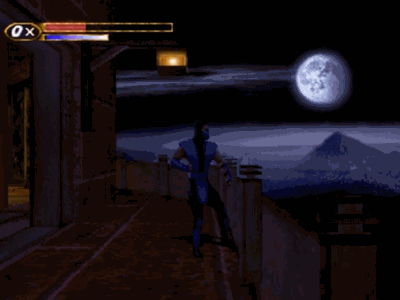
Falls flat.
And in further ill-advised developments, the good folks behind Mortal Kombat decided to go a step further past digitized human actor sprites, and hire for-real human actors to act out the important plot beats of Mythology. Regrettably, this created a sort of reverse uncanny valley effect. When you see Sub-Zero as a little digitized fighter, that’s cool, there’s Sub-Zero, he’s going to take someone’s head off, and it’s going to work out. When you see that “same” Sub-Zero as a real-life FMV person in a cutscene… uh… what am I looking at here? That’s not Sub-Zero! That’s just some dumpy dude wearing a Sub-Zero costume! And I don’t think I need to tell anyone that Playstation 1-era videogame actors were maybe not the best at selling a story. In short, in a time when “immersion” was starting to become gaming’s latest buzzword, Mortal Kombat Mythologies: Sub-Zero did its level best to practically insult the player for investing in Mortal Kombat (mythologies).
And amid all this, this is how we were introduced to Quan Chi.
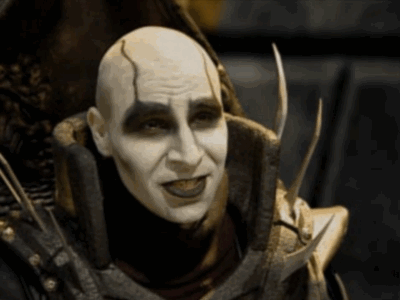
First of all, of all the kharacters introduced after Mortal Kombat 3, Quan Chi looks to be the most relevant and reoccurring. This seems to indicate that someone in the Mortal Kombatorium (where all Mortal Kombat games are made) really likes the guy. Maybe a member of the KISS Army saved Ed Boon’s life? I don’t know. Whatever the case, Quan Chi was the marquee fighter for Mortal Kombat 4, the star of MK:MS, and a frequently recurring antagonist in nearly every following Mortal Kombat title. He was slated to be DLC (with Harley Quinn!) in MK vs. DC, and he even technically premiered not in Mythologies, but as a guest villain on the animated series. He was a little off model (albeit like every MK: Defenders of Realm character), and he had a Megatronian plan to infect all the heroes with a rage virus or something to make them all fight for no reason (like… every Mortal Kombat… huh), but he was still essentially the “evil wizard” Quan Chi right from the get-go. Quan Chi is somebody’s favorite fighter in the franchise.
But you wouldn’t know that from watching MK:MS. Again, on paper, we’ve got a pretty cool customer. Quan Chi was a wizard, and, like most wizards, he needed some magical doodads for, I dunno, turning someone into a toad or whatever. Wizards are a naturally lazy bunch (you ever seen a wizard mowing the lawn?), so he hired a pair of rival ninja(esque) guilds to go and find his trinkets. Sub-Zero of the Lin Kuei not only completed the assigned task, but also murdered his rival along the way. As an extra special thank you for a job well done, Quan Chi completely obliterated the rival ninja clan, and maybe picked up a spare vengeance skeleton along the way. So, to be clear for future retkons: the final answer here is that Quan Chi murdered Scorpion’s family, and Sub-Zero only kinda inspired it. Please get your retribution right, Scorpion.
Anywho, Sub-Zero wound up with Quan Chi’s ultimate goal, a magical amulet, and dutifully handed it over to the wizard. At this point, the chalk-white wizard with freaking spikes growing out of his shoulders revealed that, gasp, he’s totally an evil wizard, and Sub-Zero was tricked into helping Quan Chi revive an ancient evil god known as Shinnok. Quan Chi escaped to Hell, and Sub-Zero followed after Raiden explained that an ancient evil god running around would be a terrible thing for the assassination business. People would be getting murdered for nothing!
So, naturally, Sub-Zero ventured down to the Netherrealm, eventually defeated Quan Chi and the divine Shinnok, and saved the day. How could an evil god empowered by his extra-special magical amulet be defeated by a mere ice ninja? Simple! Quan Chi kept the real magical amulet for himself! Oh, that rascally Quan Chi! He’ll be the death of us all!
Anywho, this cool and calculating wizard was played by the same dude as Kano, so maybe his real cunning didn’t exactly come across in his initial premiere…
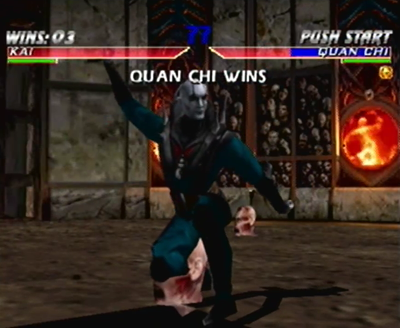
And then that brought us up to Mortal Kombat 4. Nobody liked Mortal Kombat 4.
Again, Mortal Kombat as a brand was riding high after the release of Mortal Kombat Trilogy. Unfortunately, this was also the era when games “had to” upgrade to 3-D. The old days of 2-D were dead and gone, and the mere concept that 2-D games could exist alongside their pointy colleagues was insane. Virtua Fighter, Tekken, and Battle Arena Toshinden (of all things!) were defining what fighting games could be, and Mortal Kombat wanted a piece of that sweet, polygonal pie. Thus, Mortal Kombat 4 forsook the realistic 2-D models of the olden days, and elevated the whole kast to the third dimension.
Unfortunately, nobody had a damn clue how to translate the actual Mortal Kombat gameplay to 3-D, so… woof, man. Just woof.
As previously noted, Quan Chi was the marquee kharacter of Mortal Kombat 4, as he was featured in all advertising and was plastered over the side of every Mortal Kombat 4 arcade machine. Oddly, though, he didn’t have much to actually do in Mortal Kombat 4. Shinnok was the final boss, and Goro popped up again as the sub-boss. Quan Chi was just kind of… there. He did feature prominently in a few endings, though, like when Scorpion discovered ol’ Quan was responsible for killing his family, or when Quan Chi stood over a defeated Shinnok and finally revealed that he had been holding on to the real, actually useful magical amulet this whole time. You’d think that last reveal would just be an excuse to explain why the toady defeated the master in a completely fantastical ending, but, nope, that winds up being kanon for the rest of the franchise. The finale of MK4 sees Shinnok and Quan Chi failing, but Quan Chi does manage to hold onto an amulet of unimaginable/ill-defined power. Score!
Unfortunately, unlike Quan Chi, Mortal Kombat as a cultural juggernaut could not survive its failures. Mortal Kombat Mythologies: Sub-Zero killed some good will. Mortal Kombat 4 killed even more. Mortal Kombat: Annihilation was a movie made specifically for fans of the convoluted Mortal Kombat Trilogy, but, give or take some horse punching, it was an abject failure for all but the most dedicated of ninja enthusiasts. The next attempted “Mythologies” title, Mortal Kombat: Special Forces: Starring Jax and Only Jax, was the final nail in the Mortal Kombat coffin (koffin). The Mortal Kombat franchise not only never saw a release on the Playstation/N64 console generation again, it also saw John Tobias, co-creator of MK and godfather to Noob Saibot, leave the franchise. Mortal Kombat as we knew it was gone. Mortal Kombat could return, but it would be a different animal. It would have to be.
And then Mortal Kombat returned in a totally new form on the Playstation 2 as Mortal Kombat: Deadly Alliance. And, as if to tell us that nothing had ever been learned, there was Quan Chi with his bone-licking grin, smiling back at us as the final boss. You crash the entire franchise (twice!), and you get promoted! Clearly, Quan Chi is the whitest of the MK fighters.
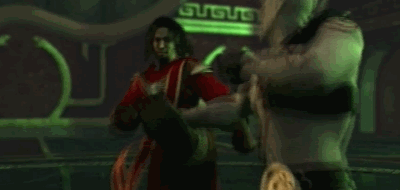
At least Quan Chi suffered a little for participating in some horrible titles. Scorpion’s MK4 ending turned out to be kanon, and he dragged Quan Chi to Hell for a substantial torture session. Given Scorpion isn’t all that great at psychological torment (he’s more of a zoning guy), you kind of have to assume this punishment involved a lot of uppercuts. A lot. Eventually, Quan Chi remembered, duh, he’s got an amulet of unspeakable power, and, with the aid of a pair of oni, he escaped the Netherrealm to discover the Tomb of the Dragon King. Thus, Quan Chi recruited Shang Tsung, formed the Deadly Alliance, and successfully killed Liu Kang, Shao Kahn (sorta), Kung Lao, Kitana, Sonya Blade, Jax, and probably severely wounded Stryker with an errant flaming skull. Having won literally everything, the Deadly Alliance inevitably fell apart when Shang Tsung gave Quan Chi the side-eye for like a second, and thus a big ol’ wizard fight broke out. Quan Chi emerged victorious, and likely would have ruled the realms had the Dragon King not shown up and wiped the floor with the survivors (who were not survivors for very much longer). Quan Chi himself saw Raiden powering up for an apocalyptic suicide blast, and decided to hightail it out of there to realms unknown. As a result, Quan Chi did not participate in Mortal Kombat: Deception, though in-game data shows that he was intended for the title, but must have been cut at the last moment. Someone finally acknowledged that we all needed a break from Quan Chi.
Quan Chi makes a comeback in Mortal Kombat: Armageddon, though, and is responsible for the networking mixer that eventually pulls all the final bosses across MK onto the same side (though everyone was disappointed that Goro only brought a cheese plate). This, of course, leads to every villain betraying every other villain simultaneously, and Shao Kahn is the ultimate victor of that “alliance”. And, as we all know, this leads to everyone being dead, and the universe being rebooted again. (Though with a brief sojourn in the DC Universe, where, despite not being a playable kharacter, Quan Chi still manages to have a significant impact on the plot.)
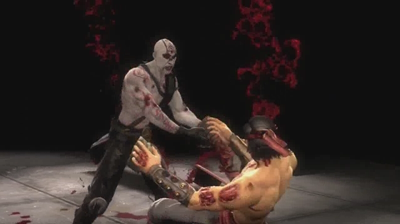
Mortal Kombat 9 was a reboot of the original Mortal Kombat Trilogy, so you might think we’d be free of Quan Chi, who did not appear during that time. And you’d be wrong! Quan Chi is the only (non DLC) fighter to appear in MK9 that was not in the original trilogy. Despite there being no explanation for such a shift in the timeline, Quan Chi has now been retkonned into being right there from the start, appearing as undead Scorpion’s manager in the original tournament. Yes, Quan Chi was apparently the Don King to Scorpion’s Mike Tyson. And when Scorpion has second thoughts about biting off Sub-Zero’s ear, Quan Chi is there to show Scorpion a PowerPoint presentation about how Subs called Scorpion’s mama fat. Thus, Quan Chi gains an undead Sub-Zero as his newest Noob, and everything is going according to plan, bwa ha ha and whatnot.
Quan Chi generally hangs around Shao Kahn’s posse, and is even responsible for reviving Shao Kahn and Sindel at the finale of nu-MK2. And then, during MK3, his big plan is finally revealed: he just wants to see the world burn. Or die. Apparently if you die in Mortal Kombat, you become a member of Quan Chi’s undead army, because QC set up a net on life’s drain or something. Quan Chi is thus now the leader of an army that includes practically everyone that died in the three Mortal Kombat tournaments… which, in this timeline, is practically everyone. Except Motaro. Motaro is dead, and he is going to stay dead. Forever.
At the point that he has literally won everything he ever wanted, Quan Chi bows out of Mortal Kombat 9, and a very lonely Raiden is left to deal with Shao Kahn. So Quan Chi returns in Mortal Kombat 10 for a redux of Mortal Kombat 4: Shinnok and Quan Chi are invading the realms, and the only hero left to oppose their tyranny is… Johnny Cage. Huh. But he (inexplicably) wins! Shinnok is beaten back into his own magical amulet during the opening of MK10, and Quan Chi is stuck (once again) trying to find a way to revive his master. At least he still has like 60% of his undead army to keep him company.
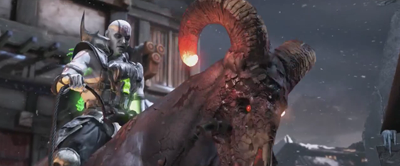
Unfortunately for Quan Chi (I love typing that), it’s not easy being a masterless evil wizard. Quan Chi is soundly beaten by Sonya in a random raid, and loses control of (undead) Scorpion, Sub-Zero, and Jax. Then, he has to recruit a gross bug lady to sneak around Outworld and steal back his (kinda his) super amulet. Then he’s captured by the Special Forces, and it’s revealed that Quan Chi is now less “evil wizard” and is closer to “marginally magical hobo”. And then it’s all over when (currently alive) Scorpion gets wind of the fact that the dude that killed his family is locked up in a cell, and decapitates the sorcerer on sight. But! Gross Bug Lady did manage to get the amulet to Quan Chi just in the nick of time, and Shinnok is revived before QC completely loses his head. Quan Chi dies as he lived, wholly and unwaveringly dedicated to Shinnok. Which is only, ya know, the complete opposite of his personality in the other timeline. Maybe he read a particularly engrossing Shinnok Tract in this timeline?
Regardless, Quan Chi is dead and buried for Mortal Kombat 11, so he’s apparently not coming back. Good riddance to bad rubbish, you franchise-killing monster. Inevitably see you next game!
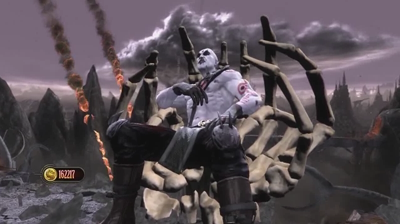
Next time: Netherrealm politics
[…] Jay and Sadistic Bob-esque relationship. Their place in the story was that they assisted Quan Chi in escaping the torture of Scorpion, but were left behind when Quan Chi actually made his way out […]
[…] In retrospect, it is very important that “Mortal Kombat 9” was officially titled simply “Mortal Kombat”. MK9 was a return to form for the franchise in one particular department: it was just Mortal Kombat. MK9 contained no kart racing, puzzle kombat, chess kombat, questionable JRPG/beat ‘em up hybrids, Hotaru: nothing. Mortal Kombat 9 was simply dudes punching dudes, a story mode featuring dudes punching dudes, and various “missions” that included slight (but interesting) variations on dudes punching dudes. The only mini games available where the “test your might”-style challenges found in the original Mortal Kombat, and… that was it. Some believed that this was all Mortal Kombat ever needed, and that hypothesis did seem to bear fruit when Mortal Kombat 9 wound up being possibly the most popular MK title since… ever. It didn’t introduce anything particularly new to the franchise, but it was capital M Mortal Kombat. And that’s how the franchise once again claimed a flawless victory, earning the swagger that had been missing since Mortal Kombat 4. […]
[…] when Mortal Kombat vs. DC Universe was happening, so planned DLC for the game, Harley Quinn and Quan Chi, got cancelled due to a complete lack of interest in Quan Chi (and the bankruptcy thing, too, I […]